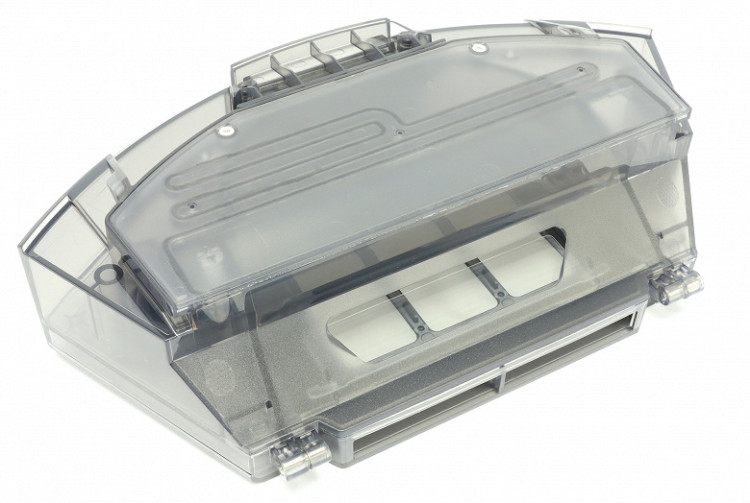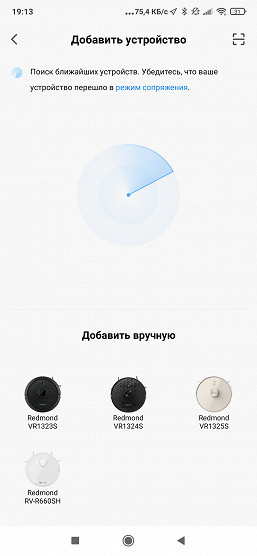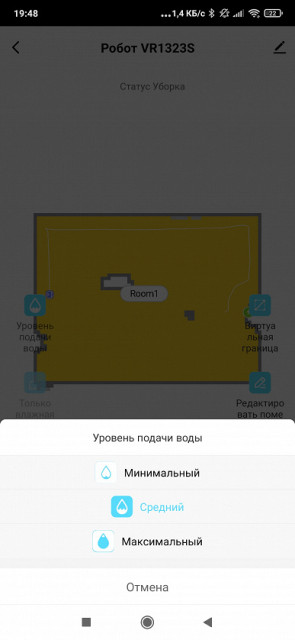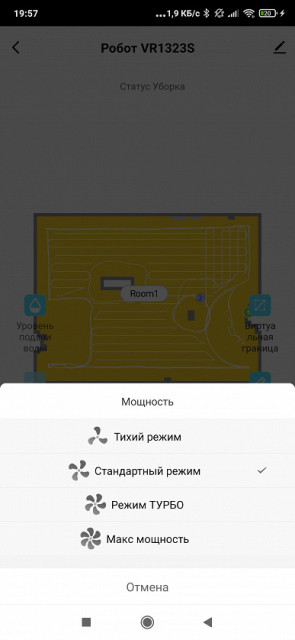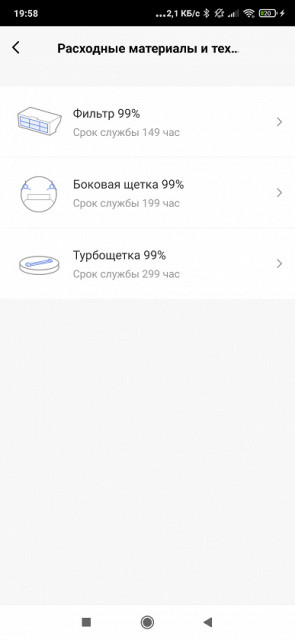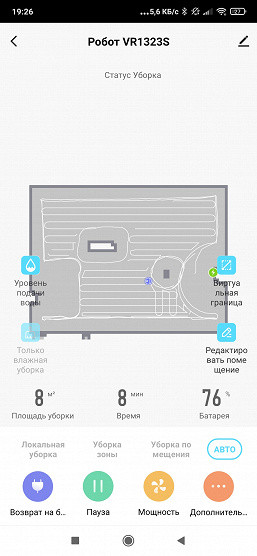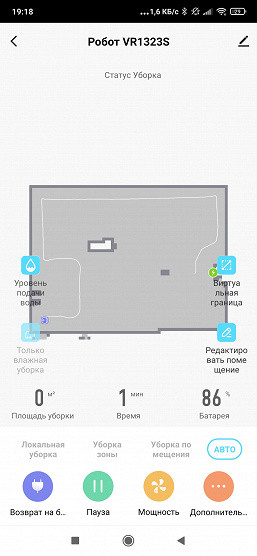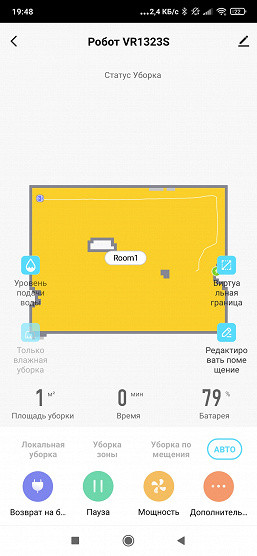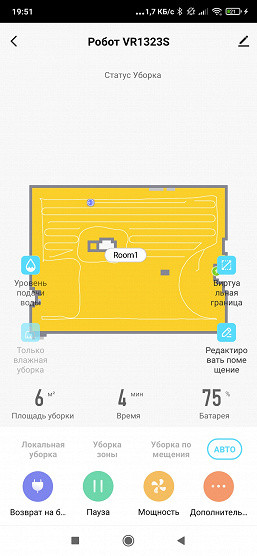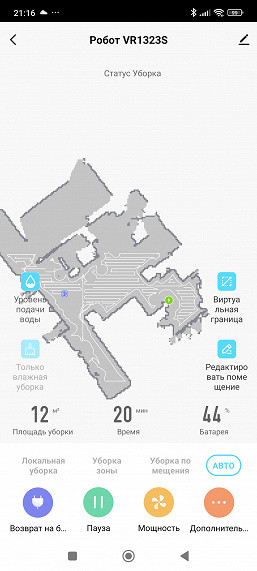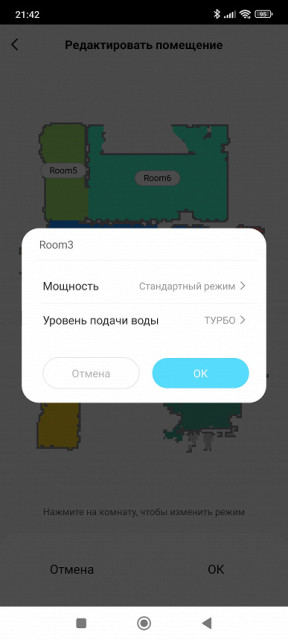The VR1323S robot vacuum cleaner from Redmond is a new product made in a classic style. This model is equipped with a lidar for navigation, one side brush and a combined container for dry and wet cleaning. The base allows you to automatically unload garbage into a bag, but there is no automatic water filling function. Let's test it in operation!
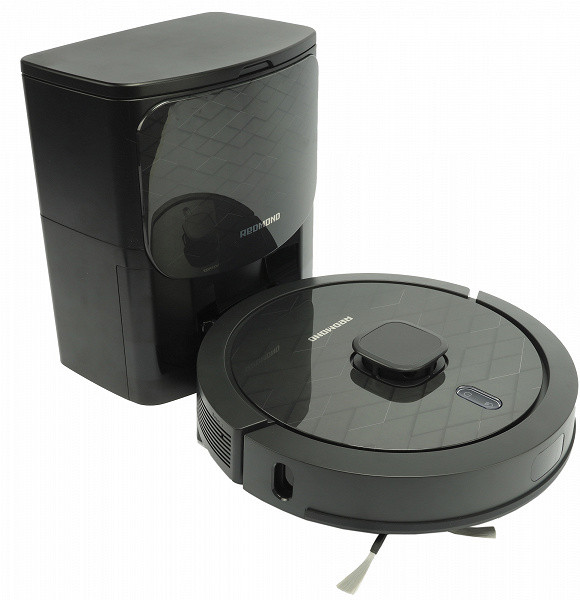
Characteristics
| Manufacturer | Redmond |
|---|---|
| Model | VR1323S WiFi |
| Type | robot vacuum cleaner with waste collection station |
| Country of origin | China |
| Guarantee | 1 year |
| Service life * | 3 years |
| Type of cleaning | dry, dry/wet |
| Sensor type | infrared optical, LDS (lidar) |
| Power | 45 W |
| Suction power | up to 4000 Pa |
| Suction power of the station | 30 kPa |
| Battery | Li-Ion, 14.4 V, 5200 mAh, |
| Opening hours | up to 250 minutes |
| Charging time | 5 h |
| Dust collector capacity | 0.3 l |
| Volume of container for wet cleaning | 0.3 l |
| Remote control | infrared |
| Control from smartphone | Wi-Fi (iOS, Android, Redmond Home app) |
| Weight | 7 kg |
| Robot weight | 2.76 kg |
| Dimensions of the robot | 349×100×350 mm |
| Dimensions of the station | 320×280×183 mm |
| Length of network cable | 1.5 m |
* Contrary to popular belief, this is not a period after which the device will necessarily break down. However, after this period, the manufacturer ceases to bear any responsibility for its functionality and has the right to refuse to repair it, even for a fee.
Equipment
The box in which the robot vacuum cleaner is packed turned out to be quite standard in size and design. On the front there is a clear image of the device itself and a smartphone with a cleaning map. On the sides there is information about the key characteristics and features of the model.
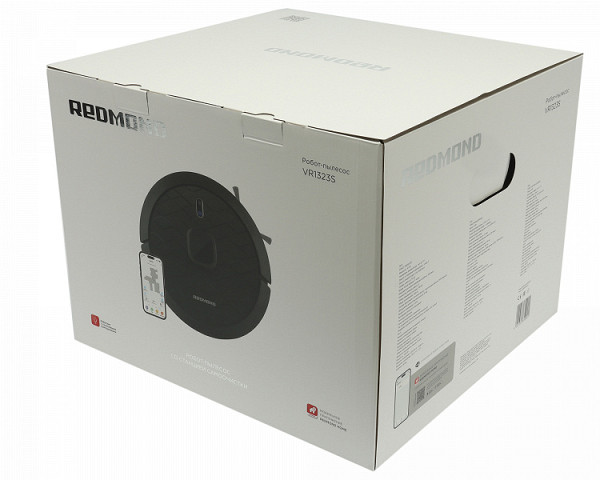
From the packaging it becomes clear that the robot vacuum cleaner supports wet cleaning and is controlled via a proprietary mobile application. For ease of transportation, the box is equipped with a plastic handle. The internal contents are reliably protected by pressed cardboard inserts, preventing damage during transportation.
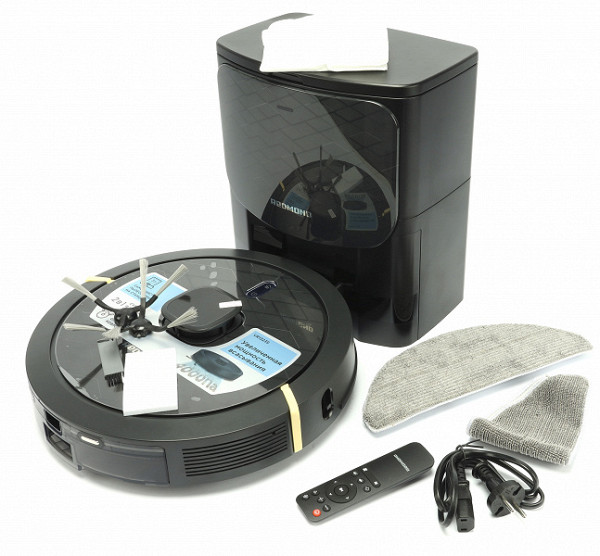
Upon opening the box, we found the following:
- a robot vacuum cleaner with a pre-installed wet cleaning module and a floor cleaning cloth,
- a base station with a power adapter,
- two side brushes (one spare),
- a remote control,
- an additional cleaning cloth,
- a spare HEPA filter,
- a knife brush for cleaning the device,
- a user manual and a service book.
At first glance
When you first look at the device, you can immediately see that this is a fairly classic model: the robot is equipped with one side brush, which is quite enough for models with a good navigation system. The kit also includes a base with a dust bag and a combination container, into which you can manually add water to moisten the wipes. Let's take a closer look at the robot and test it.
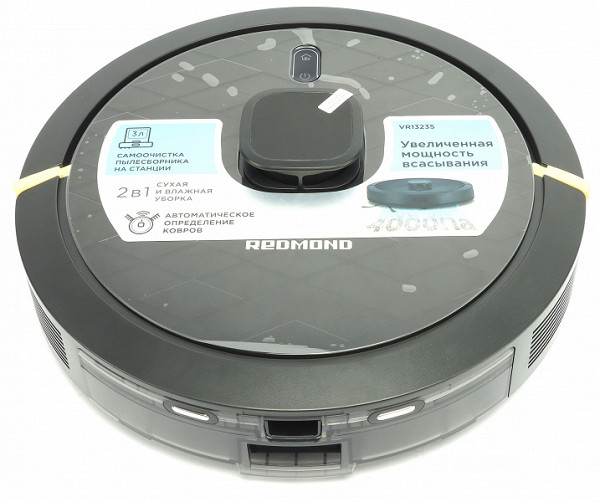
Upon opening the box, we immediately noticed the stylish design of the robot. The top cover is made of glossy plastic, which, although it easily collects fingerprints, looks attractive. The matte black plastic body does not look premium, but gives the impression of high-quality workmanship. There are two buttons on the top panel: one for starting cleaning, the other for returning to the base for recharging. In the center is a lidar turret, under which is the Redmond logo.
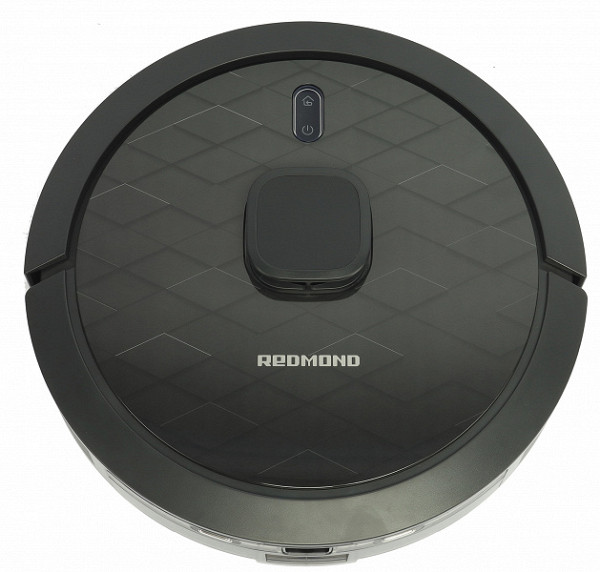
A quick look at the device shows that its design is quite standard. The front part of the body is occupied by a movable bumper, which also functions as a collision sensor. Under it, behind the darkened plastic, there is a strip of porous material that protects both the robot itself and the furniture from damage upon contact.

There are IR sensors in the center of the bumper and on the sides, allowing the robot to navigate in space and to run into walls and other obstacles less often.
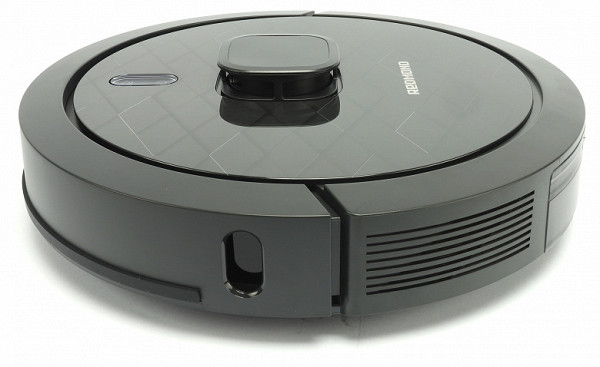
On the sides we see two grilles. Behind one of them is a speaker. The second one is used to release air.
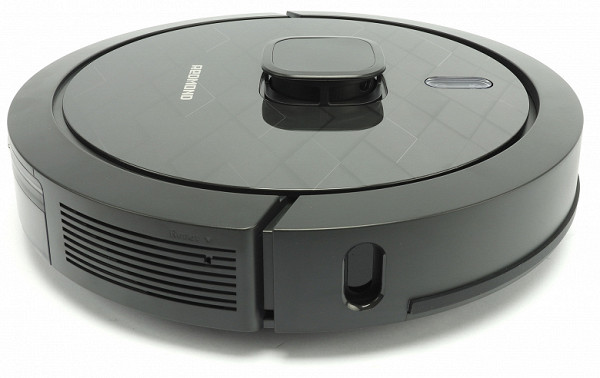
There is also a recessed Reset button hidden behind one of the grilles. It won't be easy to find it by accident.
The lidar is located in a traditional turret, slightly raised above the body.
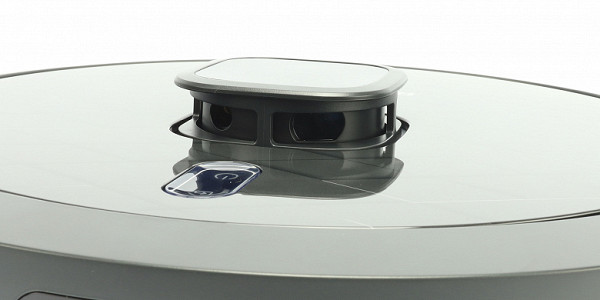
The robot vacuum cleaner is charged exclusively at the base station, so it does not have a socket for connecting a power adapter. Charging occurs through two contacts located on the dust container. A combined module is installed at the back of the device, which combines the functions of garbage collection and wet cleaning.
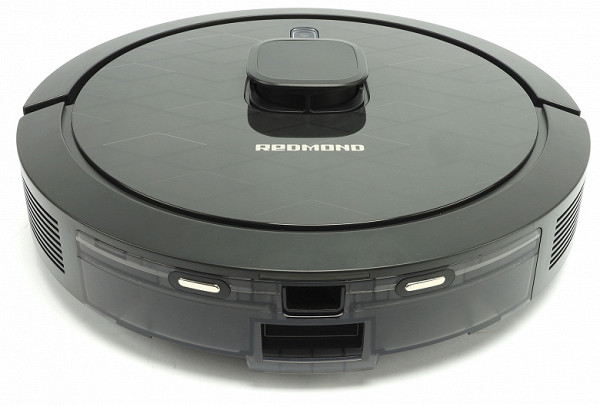
As usual, it is fixed in place with a snap button.
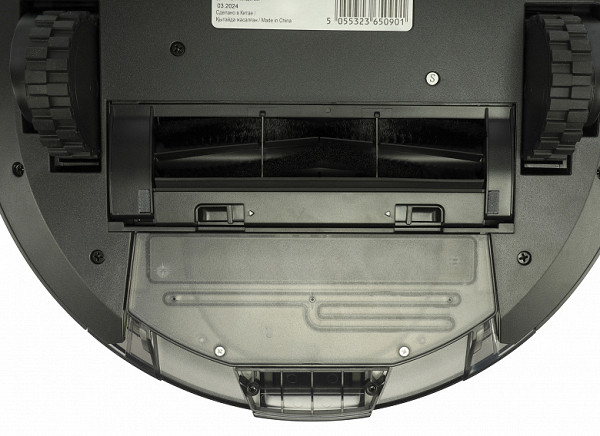
On the top of the container we see a rubber plug that closes the hole for filling with water. On the bottom there are three water supply points.
The dust is collected in a container, after which the air passes through a filter system and exits. The module can be cleaned manually, for which a special hatch is provided in the upper part.
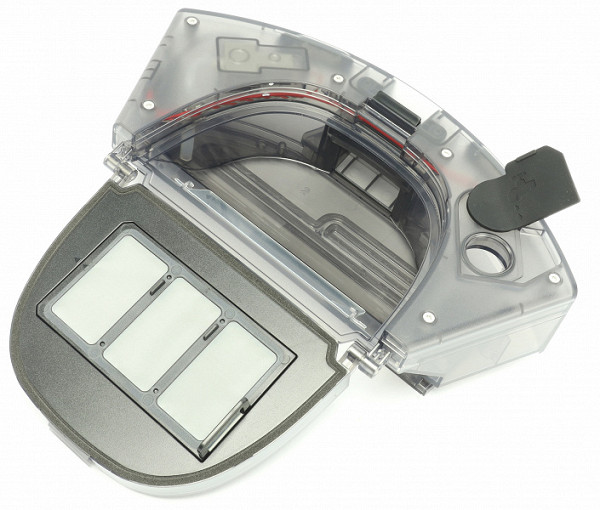
Three filters are used for filtration: a plastic frame with a synthetic mesh filter, then a foam filter and, finally, a HEPA filter for the smallest particles.

Turning the device over, we see a traditional layout: two drive wheels on the sides, a round guide roller and one side brush.
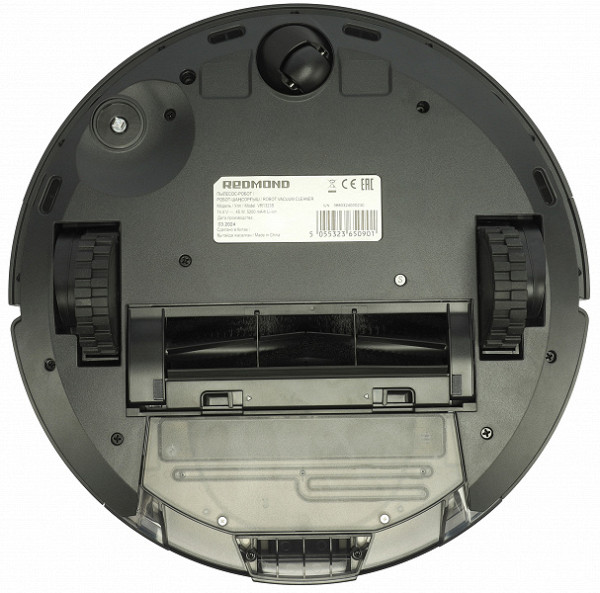
In the center is a classic rotary brush with alternating rubber slats and sweeping bristles. The movable frame ensures optimal contact with the floor. It is fixed with two latches, and two metal jumpers are provided to prevent the wires from winding around the brush.
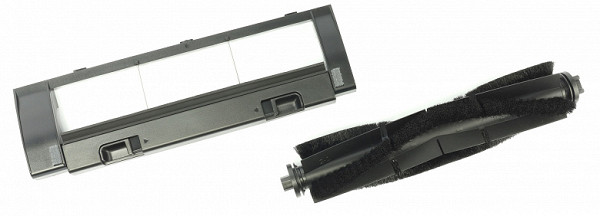
Let's look at the bottom side of the device.
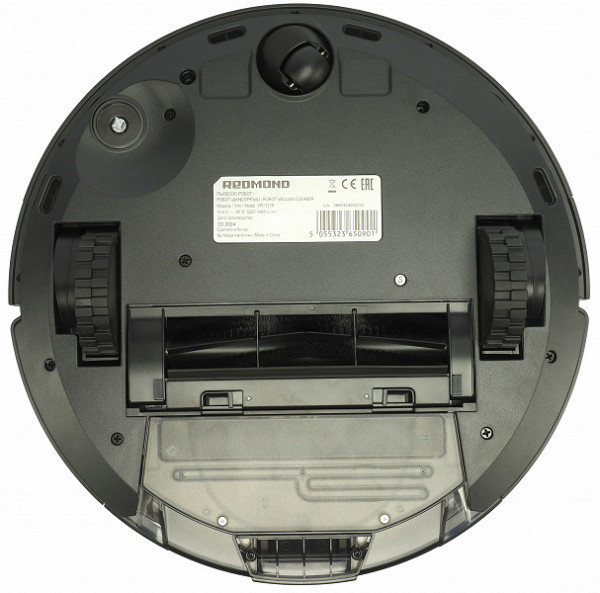
Along the outer perimeter, there are four pairs of infrared sensors that prevent the device from falling from a height, such as from a ladder. At the front of the robot is a classic guide wheel enclosed in a rotating sphere.
On the left, there is a place for installing a brush, which is fixed without special tools — it just snaps into place. Nearby is a sensor for recognizing carpets.
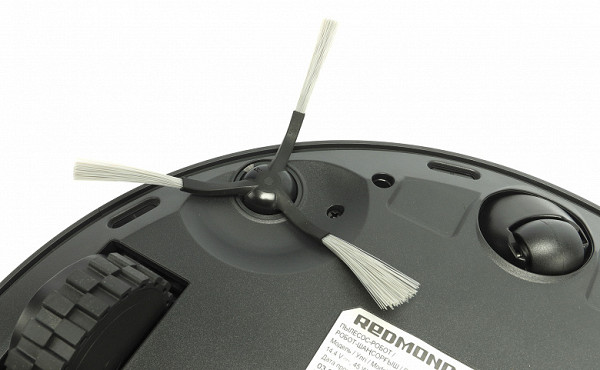
The plastic «sole» with Velcro fasteners for attaching the wet cleaning cloth is fixed to the container for garbage and water with a latch. It can be removed by pressing two side buttons.
The cloth is attached a little non-standard: it is hooked onto two hooks and is put on the sole from one edge.
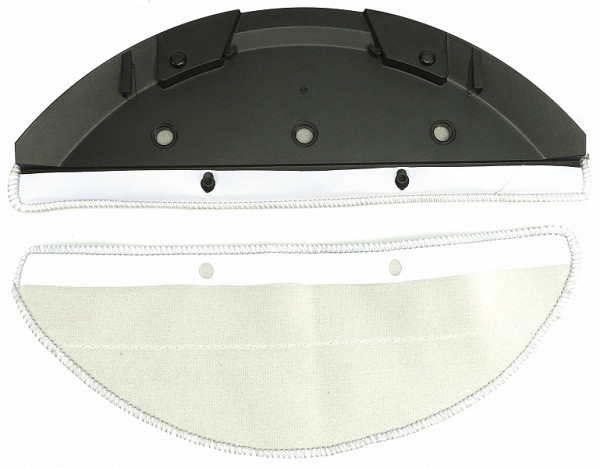
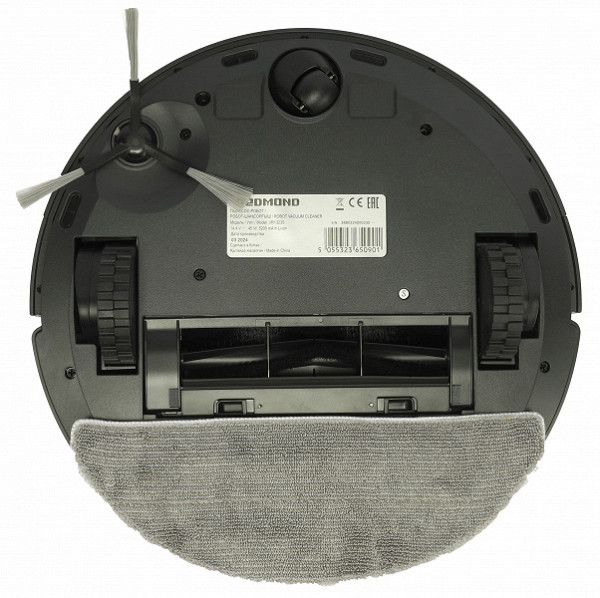
The drive wheels are equipped with rubber protectors with an «off-road» pattern, which provides excellent traction on various surfaces. The suspension travel range (from 12 to 42 mm) allows the robot to overcome obstacles up to 20 mm high and cope with other uneven surfaces.
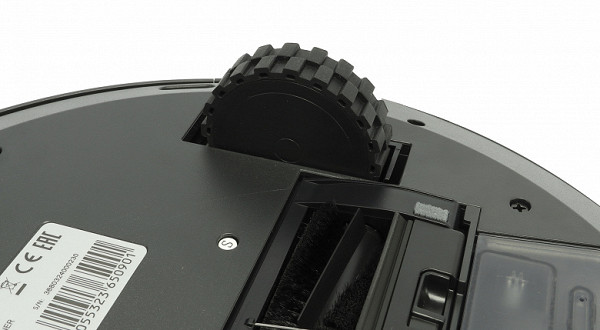
At the front, between the brushes and the support wheel, is the battery compartment. The device is powered by a traditional assembly of four 18650 cells, and the battery capacity is 5200 mAh.
Now let's move on to the self-cleaning station. It is made in the same style as the robot, with the main material made of black matte plastic. The front panel with the Redmond logo has a glossy surface, which, as before, easily collects fingerprints.
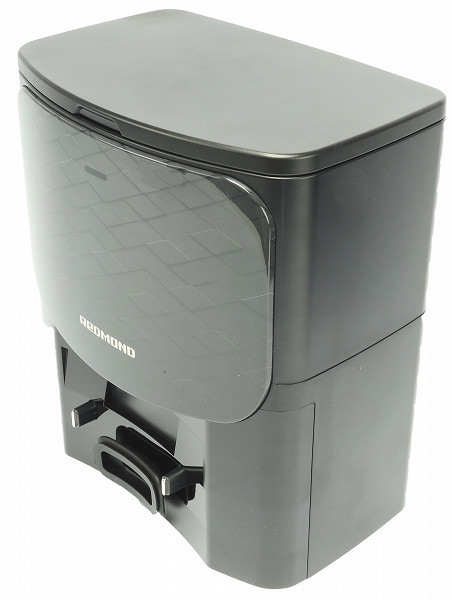
At the bottom of the station are spring-loaded contacts for charging, as well as a rubber bell for dumping collected garbage. Next to them are IR sensors that help the robot when parking.
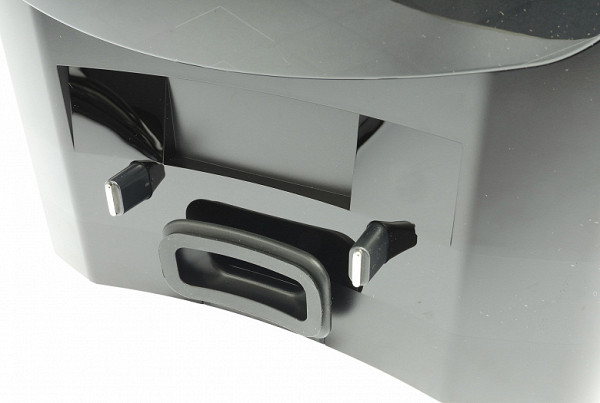
On the back of the base there is an air outlet grille, and underneath it there is a compartment for winding excess power cord.
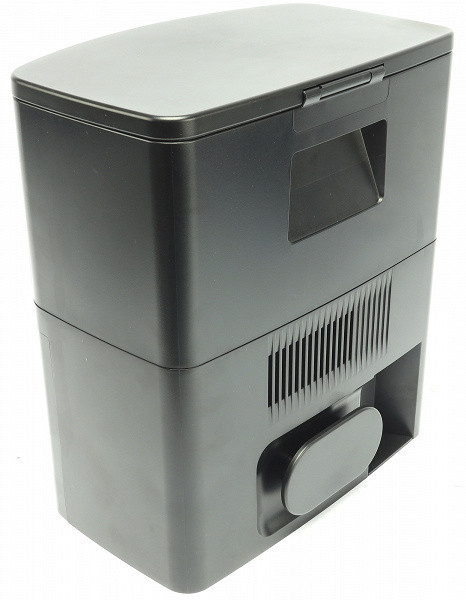
The garbage bag is installed under the hinged top cover.
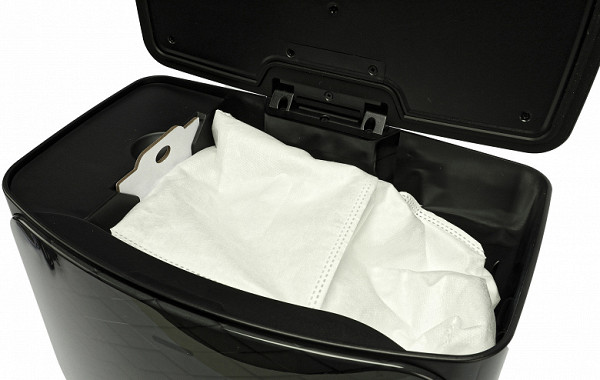
There are special guides for installing the bag on the base. At the bottom of the dust collector there is a filter that prevents debris from getting into the built-in vacuum cleaner in case the bag, for example, accidentally breaks.
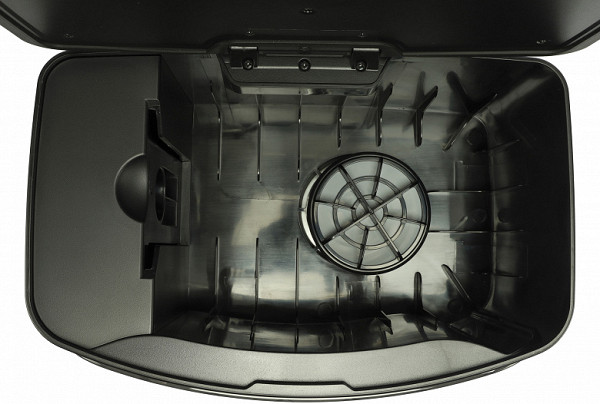
The dust bag has a capacity of 3 liters. A cardboard cover with a hole is used to fix it. However, this model does not have a traditional «curtain» to close the bag.
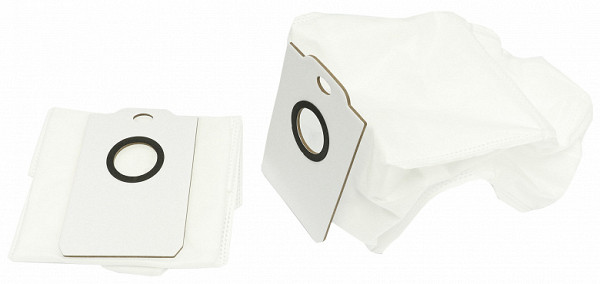
The infrared remote control does not have any special features. It allows you to give the robot standard commands, including adjusting the suction power and water flow rate. The remote control is powered by two AAA batteries.

In the kit we also found a brush-knife for cleaning the robot. First of all, it is useful for cutting off wound threads and hair, as well as for removing dust from the HEPA filter.

Instructions
The user manual is an A5 brochure, published on thick glossy paper with the traditionally excellent printing quality of Redmond.

The first 11 pages of the document are filled with diagrams and drawings that explain in detail the robot's design, operation, and maintenance.

The text part of the manual is presented in two languages - Kazakh and Russian. The Russian-language part of the manual takes up nine pages, which describe in detail the safety measures when using the device, as well as issues of control, operation and maintenance. The document ends with a list of technical characteristics and a table of possible malfunctions with recommendations for their elimination.
Control
The easiest way to control the robot is two buttons with LED backlighting on the device body. The first button turns on the device and starts cleaning in automatic mode, and the second sends it to the base for charging.
The button backlight indicators (constant glow or alternating flashing) show the current status of the device, and their meanings are described in detail in the instructions.
For initial acquaintance with the device, these buttons are quite sufficient, but it is more convenient to control the robot using the remote control, or even better — through a mobile application.
Remote control
The kit includes a small infrared remote control, which provides additional control options.
The purpose of the buttons is usually intuitive thanks to the pictogram icons:
- turning the device on/off
- returning to the charging station
- automatic mode
- local cleaning
- connecting to the network
- starting/ending cleaning
- selecting the direction of movement (in manual control)
- adjusting the suction power
- adjusting the water supply level
- turning on/off voice messages
The remote control is powered by two AAA batteries, which are not included with the device.
Control from smartphone
For more convenient control, the manufacturer recommends installing the Redmond Home app, which is available for download on Android and iOS. Let's look at its main features.
First, you will need to register by entering your email address or mobile phone number, and provide information about the location of the device.

To add a vacuum cleaner, you need to either take a photo of the QR code (for example, from the instructions) or add the device manually. Then you need to enter the name of the wireless network (Wi-Fi, 2.4 GHz) and password. The connection mode to the smartphone is activated by long pressing the button on the device body. The process takes only a couple of minutes and goes without problems.
Before starting operation, the application checks the relevance of the vacuum cleaner's built-in firmware and offers to update it if updates are available.
The main screen displays a map of the room (it is empty when first launched and appears after cleaning starts), as well as the time of the current or last cleaning, the area processed, and the battery level.
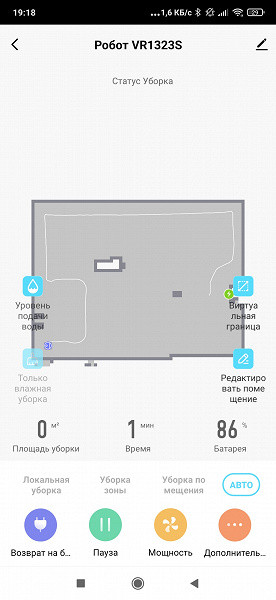
Using the buttons in the bottom row, the user can start or pause cleaning, send the device to the station, and adjust the suction power and water supply speed (setting the humidification level). Just above are the buttons for local cleaning (where you need to specify a point on the map), cleaning a selected area (it also needs to be added to the map), and cleaning one room. Thus, all the necessary modes of daily operation are easily accessible.
The statistics of the last cleaning are displayed above — the cleaned area and operating time, as well as the charge level.
The device has four power modes and three water supply speeds.
Other settings are hidden under the «additional» button.

Here you can set up scheduled cleaning, control the robot manually, edit the map, enable the power boost mode on carpets and other functions. For experienced users, everything is intuitive. The «Auto Power Boost» mode is designed for carpets, and «Continuous Cleaning» allows the robot to return to the base for recharging and continue cleaning from where it stopped.
However, for those who are encountering a robot vacuum cleaner for the first time, it would be useful to provide additional explanations to avoid misunderstandings.
In addition to the standard set of settings, we are interested in the base operating modes. We can set up garbage disposal after 1, 2 or 3 cycles, as well as completely disable this function.

Unfortunately, the favorite function «dump garbage twice during one cleaning» is missing, which may be important for large rooms or apartments with animals.
What else is available in the settings? There is the ability to monitor the wear of consumables, select the language of voice guidance, view the cleaning log, activate the «do not disturb» mode, which blocks the dumping of garbage at night, and other standard functions.
The settings page also allows you to rename the device (the app supports multiple robots at once, which helps avoid confusion), share access to the device with other accounts, and check for firmware updates.
Operation
When removing the vacuum cleaner from the box, remove the packaging and shipping materials, including the protective pads on the bumper, install the side brush and fully charge the device. The first charge may take longer, so it is better to leave the vacuum cleaner connected overnight.
Before starting to use, it is important to install the charging station correctly. The manufacturer recommends placing it close to the wall, leaving a meter on each side and two meters in front for free movement of the device. You should also remove wires, bags, shoes, toys and other items from the floor that can be damaged or knocked down during cleaning. Fragile objects and candles should be placed away from the floor or furniture to avoid accidental damage.
You can use our Redmond without a smartphone, controlling it with the buttons on the body or the remote control, but all the features are available when installing a mobile application, which is best done before starting work.
The device supports several maps and allows you to edit them manually, including combining and dividing rooms, setting virtual walls and no-go zones.
The map will be built and displayed on the smartphone screen during the first cleaning. The model perfectly matches the real room, thanks to the lidar sensor, which reliably detects obstacles and boundaries. The exception is low obstacles.
The vacuum cleaner recognizes carpets well, increasing the suction power to the maximum when the corresponding option is enabled.
Here's how the device builds a map on our test site:
And here she is in the process of cleaning.
And this is how the map looks in a real room with furniture, chairs, shoes in the hallway, etc.
The finished map is automatically divided into rooms (here our robot overdid it by adding one “extra” room).
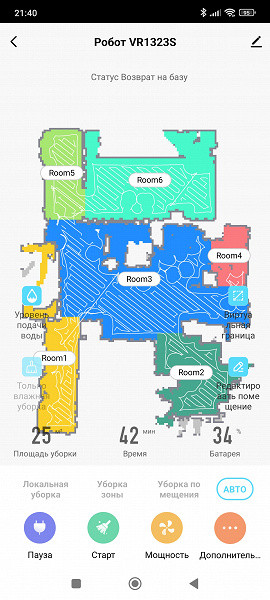
After creating the map, we can perform all the usual actions with it. Including setting our own modes (suction level and napkin moistening) for each of the rooms.
We rate the quality of wet cleaning as standard, that is, quite good. The robot effectively supplies water to the fabric, wipes the floor and leaves almost no drops or excess water.
What didn't we like? When we first launched the robot, we were surprised by an overly loud male voice — the voice messages are really very loud. Fortunately, they can be reduced via the app or turned off completely.
The second surprise was waiting for us in the «voice settings» section. After changing the language of the messages to English, we discovered that it was impossible to return the Russian voice package — only English and Chinese were available. We still haven't figured out how to solve this problem (perhaps the developer can help, and then we will update the article).
Care
The plastic parts of the device can be wiped with a damp, well-wrung-out cloth. The garbage bags are replaced as needed, and the built-in dust container does not require regular cleaning, but it is worth checking it from time to time for stuck objects.
According to the instructions, the HEPA filter can be cleaned with the included brush, but it cannot be washed.
The brushes, soleplate and floor cloth can be washed under running water using a mild detergent. They should be dried naturally. There is no information about the possibility of washing the cloths in the machine.
Other elements must be wiped manually with a damp cloth, and the sensors and contacts — with a dry soft cloth.
All parts that have come into contact with water must be thoroughly dried after cleaning.
Fortunately, the user does not need to remember all these rules: if doubts arise or if he forgets how to care for this or that element, he can always refer to the instructions, where he can refresh his memory with the help of simple and clear illustrations.
At the moment, we have no information about the availability of consumables, perhaps the model is still too new.
Conclusions
The Redmond VR1323s robot vacuum cleaner turned out to be a completely standard device of its class: the quality of cleaning, the ability to recognize obstacles and the overall functionality met our expectations. The vacuum cleaner successfully completed all test tasks, providing high quality cleaning. We were also pleasantly surprised by the mobile application, which provides convenient interaction between the user and the robot.
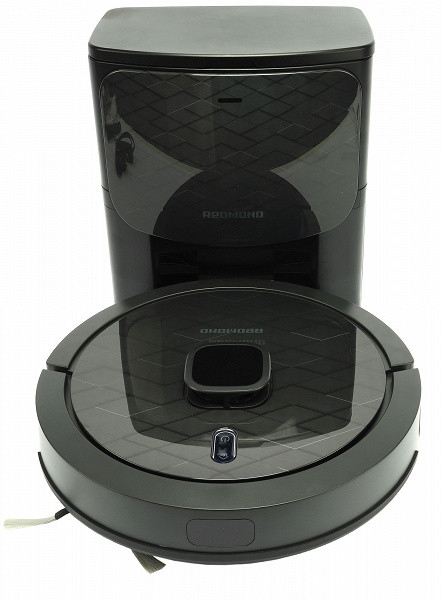
However, we didn't find any standout features or innovations worth mentioning separately. Our tests left us with the impression that this device simply does its job, looks stylish, and doesn't claim to be any particular achievement in the field of robotics.
Pros:
- dry and wet cleaning
- quality application and mapping
Cons:
- none found


